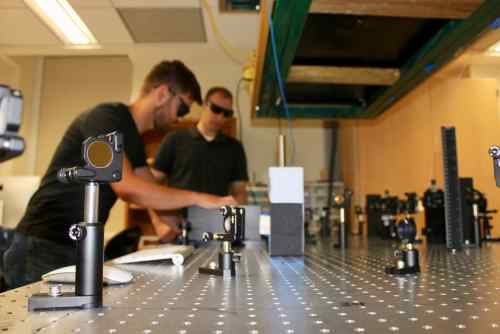Optical Engineering
Working with Assistant Professor of Physics George Keiser in his optics lab, Justin Yerkie ’19 is helping to create a system that’s able to generate terahertz frequency light.

If you think the upcoming 5G technology is a big deal, just wait until the telecommunications industry rolls out terahertz. Data transfer using terahertz light has been clocked at up to 100 Gbit/s, close to a thousand times faster than the speed of current wifi technology based on microwaves. Terahertz radiation could also be a game-changer in security screening applications and medical imaging.
“Ultimately, we want to use the light for spectroscopy to study materials, so the signal we create will be used to determine different properties such as index of refraction or absorption or reflection for certain things.”
Yerkie's interests align strongly with those of his mentor. Keiser is an experimental physicist whose research is related to studying and finding materials that interact with terahertz radiation in new and interesting ways. Before joining the faculty at Washington College in 2017, he was a postdoctoral research scientist at Brown University, researching terahertz optics and devices.
“One of the limits for the technology is that there aren't many materials that naturally absorb or emit this kind of light,” Keiser says, “so it's been hard to make lenses, filters, or modulators for it. So my research focuses on finding or engineering materials that can do this. We're trying to build a system that will generate terahertz light and also use it to study how materials interact with it.”
Taking materials found in nature, such as semi-conductors, insulators, or different types of glass, Keiser can design arrays of microscopic antennae structures that can be embedded in the particular material, changing their optical properties. These engineered “metamaterials” may be the key to novel terahertz technology and devices
“Antennas can change the way the material absorbs and transmits light,” Keiser explains. “My end goal is to use this system as a source for terahertz light that we can use to characterize samples of metamaterials that I'm interested in.”
Yerkie has another end goal—getting into a PhD program that would allow him to pursue this kind of research.
“I've really enjoyed learning how to work with lasers and different optical techniques in the lab,” he says. “Optics is a field I hadn't thought much about,” he says. “Now I see it everywhere I go.”